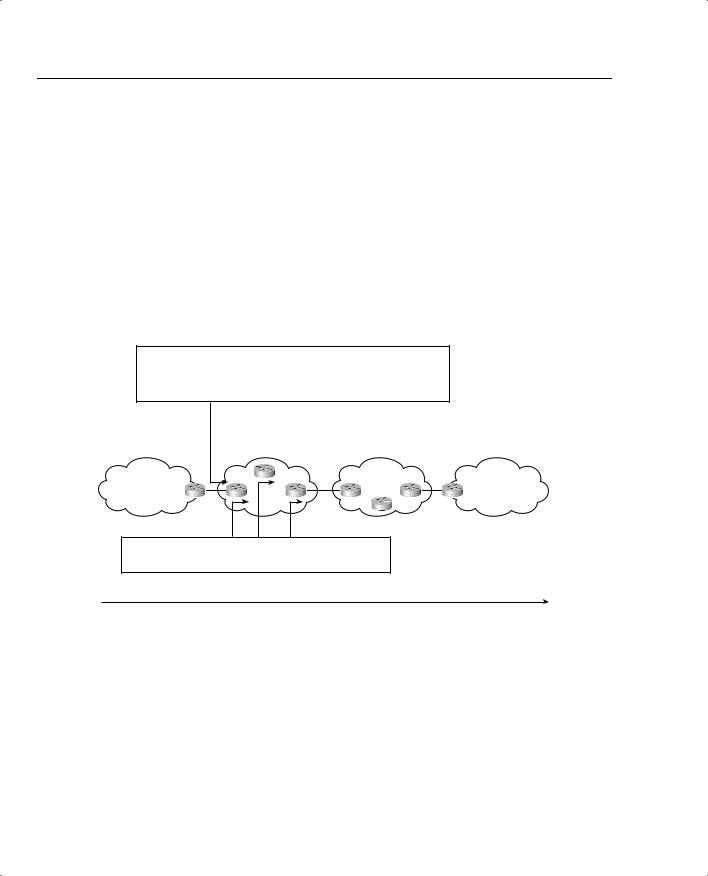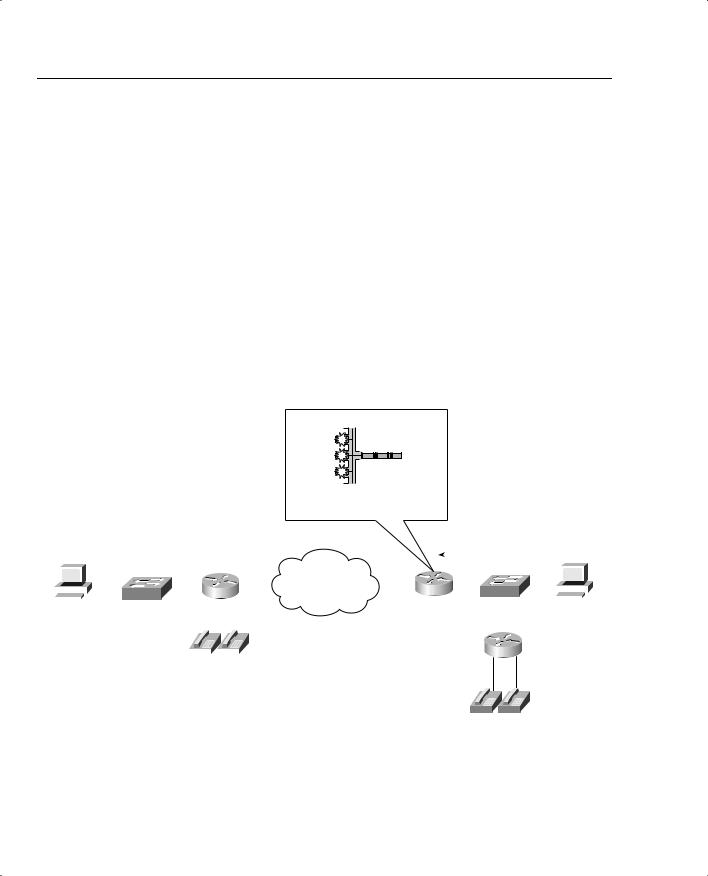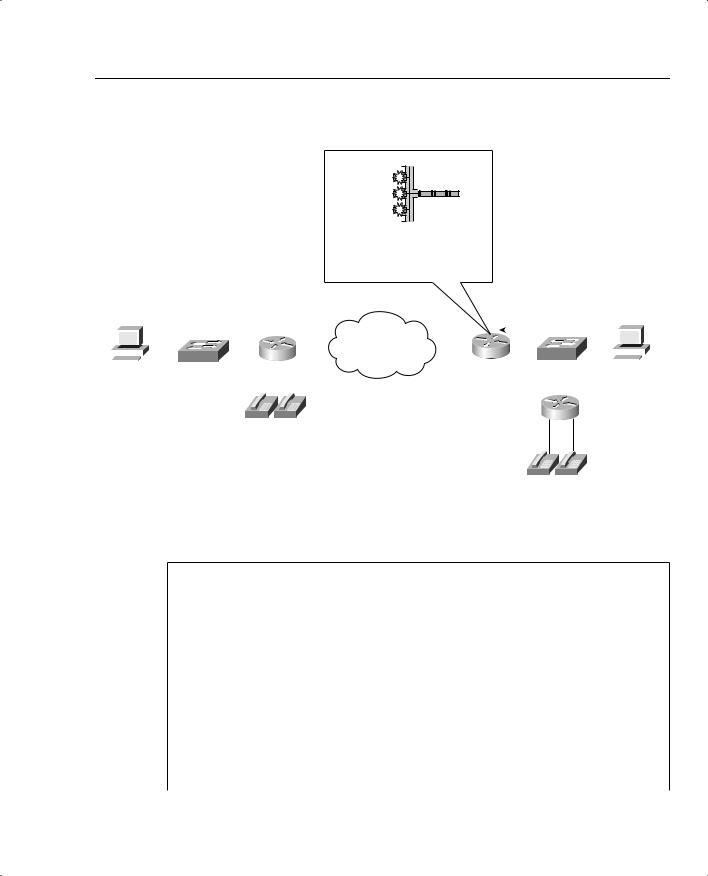
- •QoS Overview
- •“Do I Know This Already?” Quiz
- •QoS: Tuning Bandwidth, Delay, Jitter, and Loss Questions
- •Foundation Topics
- •QoS: Tuning Bandwidth, Delay, Jitter, and Loss
- •Bandwidth
- •The clock rate Command Versus the bandwidth Command
- •QoS Tools That Affect Bandwidth
- •Delay
- •Serialization Delay
- •Propagation Delay
- •Queuing Delay
- •Forwarding Delay
- •Shaping Delay
- •Network Delay
- •Delay Summary
- •QoS Tools That Affect Delay
- •Jitter
- •QoS Tools That Affect Jitter
- •Loss
- •QoS Tools That Affect Loss
- •Summary: QoS Characteristics: Bandwidth, Delay, Jitter, and Loss
- •Voice Basics
- •Voice Bandwidth Considerations
- •Voice Delay Considerations
- •Voice Jitter Considerations
- •Voice Loss Considerations
- •Video Basics
- •Video Bandwidth Considerations
- •Video Delay Considerations
- •Video Jitter Considerations
- •Video Loss Considerations
- •Comparing Voice and Video: Summary
- •IP Data Basics
- •Data Bandwidth Considerations
- •Data Delay Considerations
- •Data Jitter Considerations
- •Data Loss Considerations
- •Comparing Voice, Video, and Data: Summary
- •Foundation Summary
- •QoS Tools and Architectures
- •“Do I Know This Already?” Quiz
- •QoS Tools Questions
- •Differentiated Services Questions
- •Integrated Services Questions
- •Foundation Topics
- •Introduction to IOS QoS Tools
- •Queuing
- •Queuing Tools
- •Shaping and Policing
- •Shaping and Policing Tools
- •Congestion Avoidance
- •Congestion-Avoidance Tools
- •Call Admission Control and RSVP
- •CAC Tools
- •Management Tools
- •Summary
- •The Good-Old Common Sense QoS Model
- •GOCS Flow-Based QoS
- •GOCS Class-Based QoS
- •The Differentiated Services QoS Model
- •DiffServ Per-Hop Behaviors
- •The Class Selector PHB and DSCP Values
- •The Assured Forwarding PHB and DSCP Values
- •The Expedited Forwarding PHB and DSCP Values
- •The Integrated Services QoS Model
- •Foundation Summary
- •“Do I Know This Already?” Quiz Questions
- •CAR, PBR, and CB Marking Questions
- •Foundation Topics
- •Marking
- •IP Header QoS Fields: Precedence and DSCP
- •LAN Class of Service (CoS)
- •Other Marking Fields
- •Summary of Marking Fields
- •Class-Based Marking (CB Marking)
- •Network-Based Application Recognition (NBAR)
- •CB Marking show Commands
- •CB Marking Summary
- •Committed Access Rate (CAR)
- •CAR Marking Summary
- •Policy-Based Routing (PBR)
- •PBR Marking Summary
- •VoIP Dial Peer
- •VoIP Dial-Peer Summary
- •Foundation Summary
- •Congestion Management
- •“Do I Know This Already?” Quiz
- •Queuing Concepts Questions
- •WFQ and IP RTP Priority Questions
- •CBWFQ and LLQ Questions
- •Comparing Queuing Options Questions
- •Foundation Topics
- •Queuing Concepts
- •Output Queues, TX Rings, and TX Queues
- •Queuing on Interfaces Versus Subinterfaces and Virtual Circuits (VCs)
- •Summary of Queuing Concepts
- •Queuing Tools
- •FIFO Queuing
- •Priority Queuing
- •Custom Queuing
- •Weighted Fair Queuing (WFQ)
- •WFQ Scheduler: The Net Effect
- •WFQ Scheduling: The Process
- •WFQ Drop Policy, Number of Queues, and Queue Lengths
- •WFQ Summary
- •Class-Based WFQ (CBWFQ)
- •CBWFQ Summary
- •Low Latency Queuing (LLQ)
- •LLQ with More Than One Priority Queue
- •IP RTP Priority
- •Summary of Queuing Tool Features
- •Foundation Summary
- •Conceptual Questions
- •Priority Queuing and Custom Queuing
- •CBWFQ, LLQ, IP RTP Priority
- •Comparing Queuing Tool Options
- •“Do I Know This Already?” Quiz
- •Shaping and Policing Concepts Questions
- •Policing with CAR and CB Policer Questions
- •Shaping with FRTS, GTS, DTS, and CB Shaping
- •Foundation Topics
- •When and Where to Use Shaping and Policing
- •How Shaping Works
- •Where to Shape: Interfaces, Subinterfaces, and VCs
- •How Policing Works
- •CAR Internals
- •CB Policing Internals
- •Policing, but Not Discarding
- •Foundation Summary
- •Shaping and Policing Concepts
- •“Do I Know This Already?” Quiz
- •Congestion-Avoidance Concepts and RED Questions
- •WRED Questions
- •FRED Questions
- •Foundation Topics
- •TCP and UDP Reactions to Packet Loss
- •Tail Drop, Global Synchronization, and TCP Starvation
- •Random Early Detection (RED)
- •Weighted RED (WRED)
- •How WRED Weights Packets
- •WRED and Queuing
- •WRED Summary
- •Flow-Based WRED (FRED)
- •Foundation Summary
- •Congestion-Avoidance Concepts and Random Early Detection (RED)
- •Weighted RED (WRED)
- •Flow-Based WRED (FRED)
- •“Do I Know This Already?” Quiz
- •Compression Questions
- •Link Fragmentation and Interleave Questions
- •Foundation Topics
- •Payload and Header Compression
- •Payload Compression
- •Header Compression
- •Link Fragmentation and Interleaving
- •Multilink PPP LFI
- •Maximum Serialization Delay and Optimum Fragment Sizes
- •Frame Relay LFI Using FRF.12
- •Choosing Fragment Sizes for Frame Relay
- •Fragmentation with More Than One VC on a Single Access Link
- •FRF.11-C and FRF.12 Comparison
- •Foundation Summary
- •Compression Tools
- •LFI Tools
- •“Do I Know This Already?” Quiz
- •Foundation Topics
- •Call Admission Control Overview
- •Call Rerouting Alternatives
- •Bandwidth Engineering
- •CAC Mechanisms
- •CAC Mechanism Evaluation Criteria
- •Local Voice CAC
- •Physical DS0 Limitation
- •Max-Connections
- •Voice over Frame Relay—Voice Bandwidth
- •Trunk Conditioning
- •Local Voice Busyout
- •Measurement-Based Voice CAC
- •Service Assurance Agents
- •SAA Probes Versus Pings
- •SAA Service
- •Calculated Planning Impairment Factor
- •Advanced Voice Busyout
- •PSTN Fallback
- •SAA Probes Used for PSTN Fallback
- •IP Destination Caching
- •SAA Probe Format
- •PSTN Fallback Scalability
- •PSTN Fallback Summary
- •Resource-Based CAC
- •Resource Availability Indication
- •Gateway Calculation of Resources
- •RAI in Service Provider Networks
- •RAI in Enterprise Networks
- •RAI Operation
- •RAI Platform Support
- •Cisco CallManager Resource-Based CAC
- •Location-Based CAC Operation
- •Locations and Regions
- •Calculation of Resources
- •Automatic Alternate Routing
- •Location-Based CAC Summary
- •Gatekeeper Zone Bandwidth
- •Gatekeeper Zone Bandwidth Operation
- •Single-Zone Topology
- •Multizone Topology
- •Zone-per-Gateway Design
- •Gatekeeper in CallManager Networks
- •Zone Bandwidth Calculation
- •Gatekeeper Zone Bandwidth Summary
- •Integrated Services / Resource Reservation Protocol
- •RSVP Levels of Service
- •RSVP Operation
- •RSVP/H.323 Synchronization
- •Bandwidth per Codec
- •Subnet Bandwidth Management
- •Monitoring and Troubleshooting RSVP
- •RSVP CAC Summary
- •Foundation Summary
- •Call Admission Control Concepts
- •Local-Based CAC
- •Measurement-Based CAC
- •Resources-Based CAC
- •“Do I Know This Already?” Quiz
- •QoS Management Tools Questions
- •QoS Design Questions
- •Foundation Topics
- •QoS Management Tools
- •QoS Device Manager
- •QoS Policy Manager
- •Service Assurance Agent
- •Internetwork Performance Monitor
- •Service Management Solution
- •QoS Management Tool Summary
- •QoS Design for the Cisco QoS Exams
- •Four-Step QoS Design Process
- •Step 1: Determine Customer Priorities/QoS Policy
- •Step 2: Characterize the Network
- •Step 3: Implement the Policy
- •Step 4: Monitor the Network
- •QoS Design Guidelines for Voice and Video
- •Voice and Video: Bandwidth, Delay, Jitter, and Loss Requirements
- •Voice and Video QoS Design Recommendations
- •Foundation Summary
- •QoS Management
- •QoS Design
- •“Do I Know This Already?” Quiz
- •Foundation Topics
- •The Need for QoS on the LAN
- •Layer 2 Queues
- •Drop Thresholds
- •Trust Boundries
- •Cisco Catalyst Switch QoS Features
- •Catalyst 6500 QoS Features
- •Supervisor and Switching Engine
- •Policy Feature Card
- •Ethernet Interfaces
- •QoS Flow on the Catalyst 6500
- •Ingress Queue Scheduling
- •Layer 2 Switching Engine QoS Frame Flow
- •Layer 3 Switching Engine QoS Packet Flow
- •Egress Queue Scheduling
- •Catalyst 6500 QoS Summary
- •Cisco Catalyst 4500/4000 QoS Features
- •Supervisor Engine I and II
- •Supervisor Engine III and IV
- •Cisco Catalyst 3550 QoS Features
- •Cisco Catalyst 3524 QoS Features
- •CoS-to-Egress Queue Mapping for the Catalyst OS Switch
- •Layer-2-to-Layer 3 Mapping
- •Connecting a Catalyst OS Switch to WAN Segments
- •Displaying QoS Settings for the Catalyst OS Switch
- •Enabling QoS for the Catalyst IOS Switch
- •Enabling Priority Queuing for the Catalyst IOS Switch
- •CoS-to-Egress Queue Mapping for the Catalyst IOS Switch
- •Layer 2-to-Layer 3 Mapping
- •Connecting a Catalyst IOS Switch to Distribution Switches or WAN Segments
- •Displaying QoS Settings for the Catalyst IOS Switch
- •Foundation Summary
- •LAN QoS Concepts
- •Catalyst 6500 Series of Switches
- •Catalyst 4500/4000 Series of Switches
- •Catalyst 3550/3524 Series of Switches
- •QoS: Tuning Bandwidth, Delay, Jitter, and Loss
- •QoS Tools
- •Differentiated Services
- •Integrated Services
- •CAR, PBR, and CB Marking
- •Queuing Concepts
- •WFQ and IP RTP Priority
- •CBWFQ and LLQ
- •Comparing Queuing Options
- •Conceptual Questions
- •Priority Queuing and Custom Queuing
- •CBWFQ, LLQ, IP RTP Priority
- •Comparing Queuing Tool Options
- •Shaping and Policing Concepts
- •Policing with CAR and CB Policer
- •Shaping with FRTS, GTS, DTS, and CB Shaping
- •Shaping and Policing Concepts
- •Congestion-Avoidance Concepts and RED
- •WRED
- •FRED
- •Congestion-Avoidance Concepts and Random Early Detection (RED)
- •Weighted RED (WRED)
- •Flow-Based WRED (FRED)
- •Compression
- •Link Fragmentation and Interleave
- •Compression Tools
- •LFI Tools
- •Call Admission Control Concepts
- •Local-Based CAC
- •Measurement-Based CAC
- •Resources-Based CAC
- •QoS Management Tools
- •QoS Design
- •QoS Management
- •QoS Design
- •LAN QoS Concepts
- •Catalyst 6500 Series of Switches
- •Catalyst 4500/4000 Series of Switches
- •Catalyst 3550/3524 Series of Switches
- •Foundation Topics
- •QPPB Route Marking: Step 1
- •QPPB Per-Packet Marking: Step 2
- •QPPB: The Hidden Details
- •QPPB Summary
- •Flow-Based dWFQ
- •ToS-Based dWFQ
- •Distributed QoS Group–Based WFQ
- •Summary: dWFQ Options

Classification and Marking Tools 193
101 matches all UDP port numbers over 16,384, for traffic from Server 1 going to the client. This may catch other traffic besides NetMeeting, but it definitely catches all the NetMeeting traffic. Also note that the NetMeet class map uses a combination of capital letters and lowercase letters, as does the class command that refers to it. Class map names are case sensitive—you may want to choose to use only uppercase letters for names to avoid confusion.
The show policy-map laundry-list command just lists a summary of the configuration. You can gather the same information with a show running-config command, but it is summarized nicely with show policy-map. The show policy-map command lists the same configuration information, but it lists the information for all the configured policy maps in this router.
The show policy-map command using the interface option provides statistical information about the number of packets and bytes that have matched each class inside the policy maps. Because CB marking is configured, it also notes the number of packets that have been marked. You can select all interfaces, just one interface, either input or output, and even select a single class inside a single policy map for display.
Finally, the load-interval interface subcommand can also be useful when looking at any QoS tool’s statistics. The load-interval command defines the time interval over which IOS measures packet and bit rates on an interface. With a lower load interval, the statistics change more quickly; with a larger load interval, the statistics change more slowly. In a lab when you are just learning to use QoS tools, set the load interval to the minimum of 30 seconds, so you can see the results of new traffic, or changes to the configuration, quickly. (The default setting is 5 minutes.)
CB Marking Summary
Class-based marking provides the most functional general classification and marking tool in IOS, as of IOS 12.2 mainline. Class-based marking provides the largest number of fields for classifying packets, and the largest number of fields that can be marked. It uses MQC for configuration, separating the classification details from the QoS action.
Refer to Table 3-17, in the “Foundation Summary” section of this chapter, for a complete list of classification and marking fields used by CB marking.
Committed Access Rate (CAR)
CAR provides policing functions and marking. Chapter 5, “Traffic Policing and Shaping,” covers the policing details of CAR and CB policing. However, a quick review of policing before getting into CAR’s marking features will help you appreciate why CAR includes marking.
Policing, in its most basic form, discards traffic that exceeds a particular traffic contract. The contract has two components: a rate, stated either in bits per second or bytes per second; and a burst size, stated in either bits or bytes. The traffic conforms to the contract if it sends at the rate, or below, and it does not send a burst of traffic greater than the burst size. If the traffic exceeds

194 Chapter 3: Classification and Marking
the traffic rate over time, or exceeds the single burst size limit, the policing function drops the traffic in excess of the rate and the burst size. Therefore, the simplest form of policing has two rigid actions: either to forward packets or to drop them.
CAR’s marking function allows for additional policing action besides just forwarding or dropping a packet. Consider a typical case where policing is used, as in Figure 3-14. ISP1 needs to police traffic to protect customers who conform to their contracts from congestion created by customers who do not conform. If the network is not congested, however, it might be nice to go ahead and forward the nonconforming customer traffic. Doing so doesn’t really cost the ISP anything, so long as the network is not congested. If the network is congested, however, ISP1 wants to discard the traffic that exceeds the contract before discarding traffic that is within its respective contract.
Figure 3-14 Policing: Excess Traffic Marked with Higher Discard Value
More Benign Policing:
-If McCoy sends less than X bps, with no bursts over Y bits, then mark with a low- discard-% value, and forward the traffic
-If McCoy sends more than X bps, or bursts over Y bits, then mark the packet with a high-discard-% value, and forward the traffic
McCoy |
|
ISP2 |
Hatfield |
|
ISP1 |
Gunsmiths |
|||
Ordinance, Inc. |
||||
|
Discard Policies:
-If congestion does not occur, send everything
-If congestion occurs, discard traffic marked with a high-discard-% value
Direction of Flow of Packets in This Example
For instance, the conforming traffic can be marked with DSCP AF41, and the nonconforming traffic with DSCP Default. The congestion-avoidance QoS tools in ISP1 can be configured to aggressively discard all DSCP Default traffic at the first signs of congestion. So, when ISP1 experiences congestion, policing indirectly causes the excess traffic to be discarded; in periods of no congestion, ISP1 provides service beyond what the customer has paid for.
You can also use CAR to just mark the traffic. CAR classifies traffic based on a large number of fields in the packet header, including anything that can be matched with an IP ACL. Once

Classification and Marking Tools 195
matched, CAR can be configured to do one action for conforming traffic, and another for excess traffic. If the two actions (conform and exceed actions) are the same action, in effect, CAR has not policed, but rather has just marked packets in the same way.
CAR configuration includes the classification, marking, and enabling features all in a single configuration command: the rate-limit interface subcommand. (CB marking, you may recall, separates classification, marking, and enabling on an interface into three separate commands.) Tables 3-11, 3-12, and 3-13 list the pertinent CAR configuration and exec commands, respectively.
Table 3-11 Configuration Command Reference for CAR
|
Command |
|
Mode and Function |
|
|
|
|
|
rate-limit {input | output} [access-group [rate-limit] |
Interface mode; configures classification, |
|
|
acl-index] bps burst-normal burst-max conform-action |
marking, policing, and enabling CAR on the |
|
|
conform-action exceed-action exceed-action |
interface |
|
|
|
|
|
|
access-list rate-limit acl-index {precedence | |
Global mode; creates a CAR ACL, which |
|
|
mac-address | exp mask mask} |
can match IP precedence, MAC addresses, |
|
|
|
|
and MPLS Experimental bits |
|
|
|
|
Table 3-12 Possible Actions with CAR rate-limit Command |
|
||
|
|
|
|
|
rate-limit Conform and |
|
|
|
Exceed Options |
Function |
|
|
|
|
|
|
Continue |
Evaluates the next rate-limit command |
|
|
|
|
|
|
Drop |
Drops the packet |
|
|
|
|
|
|
set-dscp-continue |
Sets the differentiated services code point (DSCP) (0–63) and evaluates |
|
|
|
the next rate-limit command |
|
|
|
|
|
|
set-dscp-transmit |
Sets the DSCP and transmits the packet |
|
|
|
|
|
|
set-mpls-exp-continue |
Sets the MPLS Experimental bits (0–7) and evaluates the next rate-limit |
|
|
|
command |
|
|
|
|
|
|
set-mpls-exp-transmit |
Sets the MPLS Experimental bits (0–7) and sends the packet |
|
|
|
|
|
|
set-prec-continue |
Sets the IP precedence (0–7) and evaluates the next rate-limit command |
|
|
|
|
|
|
set-prec-transmit |
Sets the IP precedence (0–7) and sends the packet |
|
|
|
|
|
|
set-qos-continue |
Sets the QoS group ID (1–99) and evaluates the next rate-limit |
|
|
|
command |
|
|
|
|
|
|
set-qos-transmit |
Sets the QoS group ID (1–99) and sends the packet |
|
|
|
|
|
|
Transmit |
Sends the packet |
|
|
|
|
|

196 Chapter 3: Classification and Marking
Table 3-13 Exec Command Reference for CAR
Command |
Function |
|
|
show interfaces [interface-type interface-number] |
Displays CAR statistics on the interface speci- |
rate-limit |
fied, or on all interfaces if the interface is not |
|
specified |
|
|
show access-lists rate-limit [acl-index] |
Lists information about the configuration of |
|
rate-limit ACLs |
|
|
The first CAR marking example, shown in Example 3-5, uses the following criteria for marking packets. In this example, R3 is marking packets that flow right to left in Figure 3-15. (This example’s criteria matches that in Example 3-1 for CB marking.)
•
•
All VoIP payload traffic is marked with DSCP EF.
All other traffic is marked with DSCP Default.
Figure 3-15 CAR Marking Sample 1: VoIP Marked with DSCP EF, Everything Else Marked BE
Mark
X |
Y |
Z |
Mark VoIP with IP DSCP EF
Mark All Else with DSCP Default
Note All IP Addresses Begin: 192.168.
|
|
|
|
|
|
|
|
|
|
|
|
|
|
Packet Direction |
|||||||
Client1 |
|
|
|
|
|
|
|
|
|
Server1 |
|||||||||||
2.252 |
2.253 |
3.253 |
|
||||||||||||||||||
|
|
|
|
|
|
|
|
|
|||||||||||||
|
|
1.252 |
|
|
|
|
|
|
|
|
|||||||||||
|
|
|
|
|
|
|
|
|
|
|
|
|
|
|
|
|
|
|
|
|
|
|
|
|
|
|
SW1 |
R1 |
|
s0/0 |
s0/0 |
R3 FA0/0 SW2 |
|
|
|
|
|
||||||
|
|
|
|
|
|
|
|
|
|
||||||||||||
1.1 |
|
|
|
|
|
|
|
|
|
|
|
|
|
|
3.100 |
|
|
||||
|
|
|
|
|
|
|
|
|
|
|
|
|
|
|
|
3.254 |
|
|
|
|
|
|
|
|
|
|
|
|
|
|
|
|
|
|
|
|
|
|
|
|
|
|
|
|
|
|
|
|
|
|
|
|
|
|
|
|
|
|
|
|
|
|
|
|
|
|
|
|
|
|
|
|
|
|
|
|
|
|
|
|
|
|
|
|
|
|
|

 R4 1001 1002
R4 1001 1002
3001 3002

Classification and Marking Tools 197
Example 3-5 CAR Marking, VoIP as DSCP EF, Everything Else as BE
no ip cef
!
access-list 102 permit udp any range 16384 32768 any range 16384 32768
!
interface fastethernet 0/0
rate-limit input access-group 102 10000 20000 30000 conform-action set-dscp-transmit 46 exceed-action set-dscp-transmit 46
rate-limit input 10000 20000 30000 conform-action set-dscp-transmit 0 exceed-action set-dscp-transmit 0
end
The configuration does not take nearly as many different commands as the CB marking example, because most of the interesting parameters are contained in the rate-limit commands. Cisco Express Forwarding (CEF) is disabled, just to make the point that although you can use CEF with CAR, it is not required. ACL 102 defines some classification parameters that CAR will use to match VoIP packets, looking at UDP ports between 16,384 and 32,767. The ACL logic matches all VoIP payload, but it will also match VoIP Real Time Control Protocol (RTCP) traffic, which uses the odd-numbered UDP ports in the same port range. Finally, two rate-limit commands under FA0/0 enable CAR, define policing limits, classification details, and marking details.
The first of the two rate-limit commands matches a subset of all traffic using classification, whereas the second rate-limit command just matches all traffic. CAR uses the information configured in these two commands sequentially; in other words, if a packet matches the first CAR statement’s classification details, the statement is matched, and its actions are followed. If not, CAR compares the next statement, and so on. In this example, the first CAR rate-limit command matches VoIP packets by referring to ACL 102, and the second statement, because it does not refer to an ACL, matches all packets.
NOTE CAR can actually match multiple statements on the same interface. Some CAR actions include the keyword continue, which means that even after the statement is matched, CAR should keep searching the statements for further matches. This allows CAR to nest statements, to perform features such as “police all traffic at 500 kbps, but police subsets at 250 kbps, 200 kbps, and 150 kbps.”
Now examine the first rate-limit command, rate-limit input access-group 102 10000 20000 30000 conform-action set-dscp-transmit 46 exceed-action set-dscp-transmit 46, in detail. The input keyword means that CAR examines traffic entering the interface. The access-group

198 Chapter 3: Classification and Marking
102 command means that packets permitted by ACL 102 are considered to match this rate-limit command. The next three values represent the committed rate, the burst size, and the excess size, which make up the traffic contract. The conform-action keyword identifies that the next parameter defines the action applied to conforming traffic, and the exceed-action keyword identifies that the next parameter defines the action applied to traffic that exceeds the traffic contract. In this example, both the conform and exceed actions are identical: set-dscp-transmit 46, which marks the DSCP value to decimal 46, or DSCP EF. (The rate-limit command does not allow the use of DSCP names.)
In this example, the actual traffic contract does not matter, because the actions for conforming traffic and excess traffic are the same. The true goal of this example is just to use CAR to mark packets VoIP—not to actually police the traffic. Chapter 5 includes CAR examples with different conform and exceed actions. The three values represent the committed rate (bps), the committed burst size (bytes), and the committed burst plus the excess burst (bytes). The excess burst parameter essentially provides a larger burst during the first measurement interval after a period of inactivity. (Chapter 5 covers the details of these settings.)
The second rate-limit command, rate-limit input 10000 20000 30000 conform-action set- dscp-transmit 0 exceed-action set-dscp-transmit 0, matches all remaining traffic. The only way that CAR can classify packets is to refer to an IP ACL, or a CAR rate-limit ACL, from the rate-limit command. The second rate-limit command does not refer to an ACL with the access-group keyword, so by implication, the statement matches all packets. Both actions set the DSCP value to zero. Essentially, this example uses CAR to mark traffic with either DSCP 46 or 0 (decimal), without discarding any packets due to policing.
The second sample CAR configuration, Example 3-6, includes classification options similar to CB marking Example 3-4. Because CAR cannot take advantage of NBAR, CAR cannot look at the URL for HTTP requests, as the CB marking example did. The slightly modified criteria for CAR marking in Example 3-6 is as follows:
•VoIP payload is marked with DSCP EF.
•NetMeeting voice and video from Server1 to Client1 is marked with DSCP AF41.
•Any HTTP traffic is marked with AF22.
•All other traffic is marked with DSCP Default.
Figure 3-16 shows the network in which the configuration is applied, and Example 3-6 shows the configuration.

Classification and Marking Tools 199
Figure 3-16 CAR Marking Sample 2 Network
Mark
X |
Y |
Z |
Mark VoIP as DSCP EF
Mark NetMeeting as DSCP AF41
Mark HTTP as DSCP AF22
Mark All Else with DSCP Default
Client1 |
|
|
|
|
|
Packet Direction |
Server1 |
|||||||||||||||
|
|
|
|
|
|
|
|
|
|
|
|
|
|
|
|
|
|
|
|
|
|
|
|
|
|
|
|
|
|
|
|
|
|
|
|
|
|
|
|
|
|
|
|
|
|
|
|
|
|
|
SW1 |
R1 |
|
s0/0 |
s0/0 R3 FA0/0 SW2 |
|
|
|
|
|
|
|||||||
|
|
|
|
|
|
|
|
|
|
|
||||||||||||
|
|
|
|
|
|
|
|
|
|
|
|
|
|
|
|
|
|
|
|
|
|
|
|
|
|
|
|
|
|
|
|
|
|
|
|
|
|
|
|
|
|
|
|
|
|
|
|
|
|
|
|
|
|
|
|
|
|
|
|
|
|
|
|
|
|
|
|
|
R4
1001 1002
3001 3002
Example 3-6 CAR Marking Sample 2: VoIP, NetMeeting Audio/Video, HTTP URLs, and Everything Else
no ip cef |
|
|
! |
|
|
access-list 110 permit |
udp any range 16384 32768 any range 16384 32768 |
|
! |
|
|
access-list 111 permit |
udp host 192.168.1.100 gt 16383 |
192.168.3.0 0.0.0.255 gt 16383 |
! |
|
|
access-list 112 permit |
tcp any eq www any |
|
access-list 112 permit |
tcp any any eq www |
|
! |
|
|
! |
|
|
interface fastethernet |
0/0 |
|
rate-limit input access-group 111 8000 20000 30000 conform-action |
||
set-dscp-transmit 34 |
exceed-action set-dscp-transmit |
34 |
rate-limit input access-group 110 8000 20000 30000 conform-action |
||
set-dscp-transmit 46 |
exceed-action set-dscp-transmit |
46 |
rate-limit input access-group 112 8000 20000 30000 conform-action |
||
set-dscp-transmit 20 |
exceed-action set-dscp-transmit |
20 |
continues
